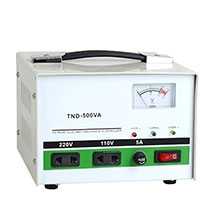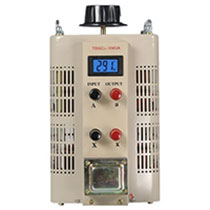Difference Between Voltage Stabilizer and Voltage Regulator
Both voltage stabilizer and voltage regulator are power protection devices. Many buyers do not know the difference between them and often choose the wrong one. This article will solve your doubts.

Features of Voltage Stabilizer
A voltage stabilizer is a device that stabilizes the output voltage. It can automatically adjust the power supply circuit or power supply equipment of the output voltage, and stabilize the power supply voltage that fluctuates greatly and fails to meet the requirements of electrical equipment within its set value range, so that various circuits or electrical equipment can work normally under the rated working voltage. The voltage stabilizer is composed of a voltage regulation circuit, a control circuit, and a servo motor. When the input voltage or load changes, the control circuit performs sampling, comparison and amplification, and then drives the servo motor to rotate, so that the position of the carbon brush of the voltage regulator changes, and the coil turns ratio is automatically adjusted to maintain the stability of the output voltage. It is mostly used in large or high-precision equipment. The point is to stabilize the voltage, that is, to fix the fluctuating and unregulated voltage to a stable range value.
Features of Voltage Regulator
The voltage regulator is to adjust the original voltage to the voltage value required by the device. Its input range is any sliding from 0V to the rated value range, and the point of the input voltage can be adjusted at any time to meet the stability of the output voltage. Like a transformer, it is a device that uses the principle of electromagnetic induction to change the AC voltage to achieve voltage conversion according to a certain transformation ratio. The only difference is that it has a control motor that can adjust the output voltage by changing the coil tie ratio.
The structure of the voltage regulator is similar to that of a wound asynchronous motor, but because it often works under braking, its working principle is actually similar to that of a transformer. The voltage regulator is equipped with a worm gear transmission mechanism, so as to make the rotor produce angular displacement; or make the rotor brake. When the relative angular position of the rotor changes, for the single-phase voltage regulator, the interlinkage magnetic flux between the stator winding and the rotor winding changes, so that the induced potential of the secondary winding changes; for the three-phase voltage regulator, the change The phase of the induced potential on the stator winding and the rotor winding, and the output voltage also obtains a smooth and stepless change through the self-coupling line connection surface.
transformer. The voltage regulator is equipped with a worm gear transmission mechanism, so as to make the rotor produce angular displacement; or make the rotor brake. When the relative angular position of the rotor changes, for the single-phase voltage regulator, the interlinkage magnetic flux between the stator winding and the rotor winding changes, so that the induced potential of the secondary winding changes; for the three-phase voltage regulator, the change The phase of the induced potential on the stator winding and the rotor winding, and the output voltage also obtains a smooth and stepless change through the self-coupling line connection surface.
Conclusion
To put it simply, voltage regulator is manual. Operators boost the voltage manually when the voltage is low, and manually put it to the non-boosting position when the voltage is high. Voltage stabilizer is an automatic voltage regulator. It is a circuit that uses the output voltage as a reference system. When the output is low, it automatically boosts the voltage, and when the output is high, it automatically decreases. The voltage regulator can adjust the required voltage according to the actual situation of the user. The voltage stabilizer can only stabilize the fluctuating and unstable voltage at the preset voltage value in the factory. Although both the voltage stabilizer and the voltage regulator change the voltage, but their functions are different. You could choose according to the actual situation.

